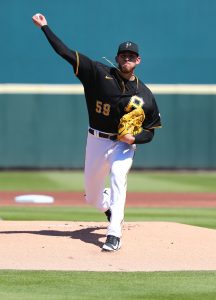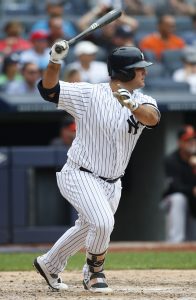The Padres keep trying to find the perfect roster mix to supplement their rising young talent.
Major League Signings
- Drew Pomeranz, LHP: four years, $34MM
- Craig Stammen, RHP: two years, $9MM (includes $1MM buyout of $4MM club option for 2022)
- Pierce Johnson, RHP: two years, $5MM (includes $1MM buyout of $3MM club option for 2022)
- Total spend: $48MM
Trades and Claims
- Acquired OF Tommy Pham and INF Jake Cronenworth from Rays in exchange for OF Hunter Renfroe, INF Xavier Edwards and INF Esteban Quiroz (as PTBNL)
- Acquired RHP Emilio Pagan from Rays in exchange for OF Manuel Margot and C/OF Logan Driscoll
- Acquired OF Trent Grisham and RHP Zach Davies from Brewers in exchange for 2B/SS Luis Urias and LHP Eric Lauer
- Acquired 2B Jurickson Profar from Athletics in exchange for C Austin Allen and OF Buddy Reed (as PTBNL)
- Claimed INF Breyvic Valera off waivers from the Blue Jays
Notable Minor League Signings
- Abraham Almonte, Kyle Barraclough, Gordon Beckham (since released), Brian Dozier, Jerad Eickhoff, Seth Frankoff, Juan Lagares
Notable Losses
- Carl Edwards Jr., Robbie Erlin, Travis Jankowski, Ian Kinsler (retired), Aaron Loup, Kazuhisa Makita, Nick Margevicius, Bryan Mitchell, Chris Stewart, Robert Stock, Adam Warren, Eric Yardley
As usual, the Padres engaged in quite a lot of eyebrow-raising chatter this winter. There was talk at various points that the club was chasing trades involving Mookie Betts (see here), Kris Bryant (see here), Francisco Lindor (see here), Nick Senzel (same link), and Starling Marte (see here). In free agency, the Friars looked at veteran southpaws Madison Bumgarner and Dallas Keuchel … and also considered another in David Price as part of various trade scenarios.
There’s no new star in San Diego, but that probably wasn’t necessary for an organization that last year welcomed Manny Machado and oversaw the emergence of Fernando Tatis Jr. and Chris Paddack. It might have been nice to announce a new, long-term pact with Tatis. The San Diego organization built up some good will by promoting him to start the 2019 season — that’ll also ensure a full season of 2020 service even if the campaign isn’t played — but couldn’t make apparent headway in talks this winter.
While committing distant future money to a franchise star would’ve been possible, the Friars didn’t have much near-term payroll space to work with. The Padres tried but failed to deal Wil Myers to achieve greater flexibility, so for now they’re left saddled with the remaining three years and $61MM on his heavily back-loaded contract. After a bunch of non-tender decisions and some mostly modest salary additions, the team is sitting at about $144MM in cash payroll for 2020.
So, what did Padres GM A.J. Preller accomplish in his sixth offseason at the helm of baseball operations? Much of the work was in a set of four interesting swaps with three value-focused trade partners.
Most of all, Preller swung an outfield overhaul. Tommy Pham and Trent Grisham each came over as part of multi-player trades that defy characterization as “buy” or “sell”-side transactions for either the Padres or their respective trade partners in Tampa Bay and Milwaukee.
Pham is only controlled for two more seasons, but he could contribute a ton of excess value if he keeps hitting. He’ll replace Hunter Renfroe, one of the players for whom he was traded. Grisham brings a lot more long-term control and some real promise but isn’t nearly as established. He’ll slot into the mix at all three outfield spots, perhaps pairing with minor-league signee Juan Lagares to handle much of the work in center. Otherwise, the Friars will shrug and hope for the best from Myers and oft-injured youngster Francy Cordero. Another young left-handed slugger, Josh Naylor, could also factor into the mix. With a strong showing in the upper minors (if a season is played there), well-regarded prospect Taylor Trammell could force his way into the picture at some point.
As is the case for much of the rest of the San Diego roster, it’s possible to imagine the outfield unit playing at quite a high level … or being rather a marginal outfit. There’s decidedly more star power in the infield, though perhaps the outlook comes with the same sort of qualifications.
Barring injury, the left side of the infield will be occupied almost exclusively by aforementioned wunderkind Tatis and top-dollar star Machado. Greg Garcia is the primary reserve/fill-in option, with Ty France and newcomer Jake Cronenworth also on the 40-man. Francisco Mejia and Austin Hedges remain entrenched behind the dish, with hopes one or both will make strides in 2020. At first base, the Pads may ultimately have to decide whether to reduce the time of the disappointing Eric Hosmer. It’s arguable that the best alignment would involve a time share between Hosmer and Myers, however hard that would be to swallow given each former Royal’s weighty contract.
Ian Kinsler’s decision to elect retirement after a tough 2019 showing unexpectedly cleared some salary and seemed to pave a path to regular at-bats for top prospect Luis Urias — but the club obviously didn’t fully believe in him as a replacement. He ended up departing in the Grisham swap. The Padres gave up a bit of young talent to take over the final season of arbitration eligibility of Jurickson Profar, a formerly elite prospect (from back when he and Preller were with the Rangers organization) who was a mostly uninspiring performer in 2019. He’ll battle at second base with minor-league signee Brian Dozier. It wouldn’t be surprising to see that situation ultimately end up in a timeshare (with Garcia, France, and/or Cronenworth potentially involved).
Those aforementioned outfield moves spelled the end of the line for Manuel Margot in San Diego. He ended up being shipped out along with 2019 second-rounder Logan Driscoll in order to acquire reliever Emilio Pagan. The late-blooming Pagan brings highly appealing K/BB numbers and a big swinging-strike rate out west, but it seems rather curious that he will now be on his fourth MLB team in four seasons. Pagan carried an unsustainable strand rate (94.8%) to reach a 2.31 ERA last year and has been rather prone to the long ball (1.58 per nine for his career).
The Padres have visions of Pagan joining closer Kirby Yates to form a powerful combination of late-inning righties. Completing the high-leverage mix is southpaw Drew Pomeranz, who rode his second-half surge to a much bigger-than-expected contract and a surprising return to San Diego. The 31-year-old was flat-out dominant down the stretch, but it was still stunning to see the Friars go to a four-year guarantee to lure him. Further bullpen-building came in the form of more modest two-year pacts to bring back Craig Stammen and add interesting NPB returnee Pierce Johnson, who whiffed 91 hitters through 58 2/3 innings en route to a 1.38 ERA with the Hanshin Tigers in Japan last season.
The depth seems like it’ll be necessary. Young hurlers Andres Munoz and Reggie Lawson were each lost to Tommy John surgery in camp. The Padres can still turn to a host of other young arms, but most come with questions. Southpaw Matt Strahm (who has much better career numbers as a reliever) and converted infielder Javy Guerra seem likely to join the ’pen once the season begins. Luis Perdomo, Adrian Morejon, Michel Baez, Ronald Bolanos, David Bednar, Jose Castillo, Trey Wingenter, and Gerardo Reyes and sixth starter Cal Quantrill are all 40-man options as well — some with real upside — but you’d have a hard time arguing any as sure things.
That leaves a rotation mix that mostly went untouched over the winter. The Friars did bring in Zach Davies while parting with Eric Lauer as the other half of the Grisham/Urias swap. It’s too much to expect a repeat of his 2019 showing (31 starts of 3.55 ERA ball), but Davies should be a solid part of the staff. The same holds true of Joey Lucchesi, who returns along with the upside-laden trio of Paddack, Garrett Richards, and Dinelson Lamet to form quite an interesting rotation mix. It would be even more exciting to see this group in a full season, when it could be supplemented by top prospects MacKenzie Gore and Luis Patino, but that’s all coming soon enough.
2020 Season Outlook
It’s awfully tough to look at this roster and see a threat to the powerhouse Dodgers. But all bets are off in a short-season format, which is likely all we’ll get if the 2020 season is played at all. And there’s reason for the Padres to hope they’ve done enough at least to compete for a Wild Card spot, though it’s a crowded NL field and it’ll be tough to make mid-season improvements given the (seeming) lack of payroll breathing room.
How would MLBTR fans grade the Padres’ offseason dealings? (Link to poll for Trade Rumors mobile app users)


